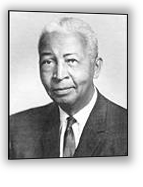Lloyd Hall
by Andrew Boyd
Today, we engineer food. The University of Houston's College of Engineering presents this series about the machines that make our civilization run, and the people whose ingenuity created them.
Lloyd Hall was an achiever. Born near Chicago in 1894, he captained his high school debate team and graduated near the top of his class. And he accomplished all this while participating in football, baseball, and track. Hall was offered many college scholarships.  He chose to attend nearby Northwestern University, where he earned an undergraduate degree in pharmaceutical chemistry. Hall went on to do graduate studies at the University of Chicago.
He chose to attend nearby Northwestern University, where he earned an undergraduate degree in pharmaceutical chemistry. Hall went on to do graduate studies at the University of Chicago.
His academic record was so good, Hall got his first job with just a telephone interview. But when he showed up at work, they wouldn't let him in. That's because he was black.
But Hall's life isn't a story of what didn't happen. It's a story of accomplishment — accomplishment with food.
A look at the ingredients in our packaged foods shows just how much we depend on additives — additives for flavor and freshness. In the early twentieth century the study of food chemistry was just gaining momentum. Hall rode the wave. Smart and capable, he quickly made his mark.
By age twenty-four, Hall was Chief Chemist at the meat processing giant John Morrell. Seven years later, he held the position of Chief Chemist and Director of Research at Griffith Laboratories — a company specializing in food processing.
Hall hit his stride at Griffith where, in addition to his administrative duties, he filed dozens of patents. Most dealt with preserving the shelf life of food. Food spoils because of micro-organisms in the air. Spoilage is slowed when these tiny creatures can't reach the food or when something's done to eradicate them — or at least slow their growth.
One of Hall's earliest patents was for a "Protective Coating" for meat. It improved upon then state-of-the-art gelatin or candle wax. The patent describes a "tough, elastic, transparent" coating that can be made "… as thick as desired to protect against … infestation …" Hall filed patents for curing meat with salt, nitrates, and nitrites; patents with names like a "Curing Process for Bacon." The patent "Sterilizing Foodstuffs" describes how to contain micro-organisms using the gas ethylene oxide. Hall even went on to file a patent for sterilizing hospital supplies. Ethylene oxide is used to this day for sterilization, though not widely because of health concerns.
The food chemistry industry's changed a lot since the early twentieth century. Preserving food's still very important. It's vital for feeding the world. But there's more focus on the long term health effects of what we do to our food — and that's a good thing. Many of Hall's patents were right for their time. However, they wouldn't be received so enthusiastically today.
Hall helped put us on the road to better and safer food distribution. As we seek healthier alternatives, we can never forget what pioneers like Hall did to help us get food on the world's tables.
I'm Andy Boyd at the University of Houston, where we're interested in the way inventive minds work.
For more information on Hall's patents, see the web site of the U.S. Patent and Trademark Office.
See the Wikipedia page about Hall.
To the best of our knowledge, Lloyd Hall's widely reproduced photo (above) is in the public domain.